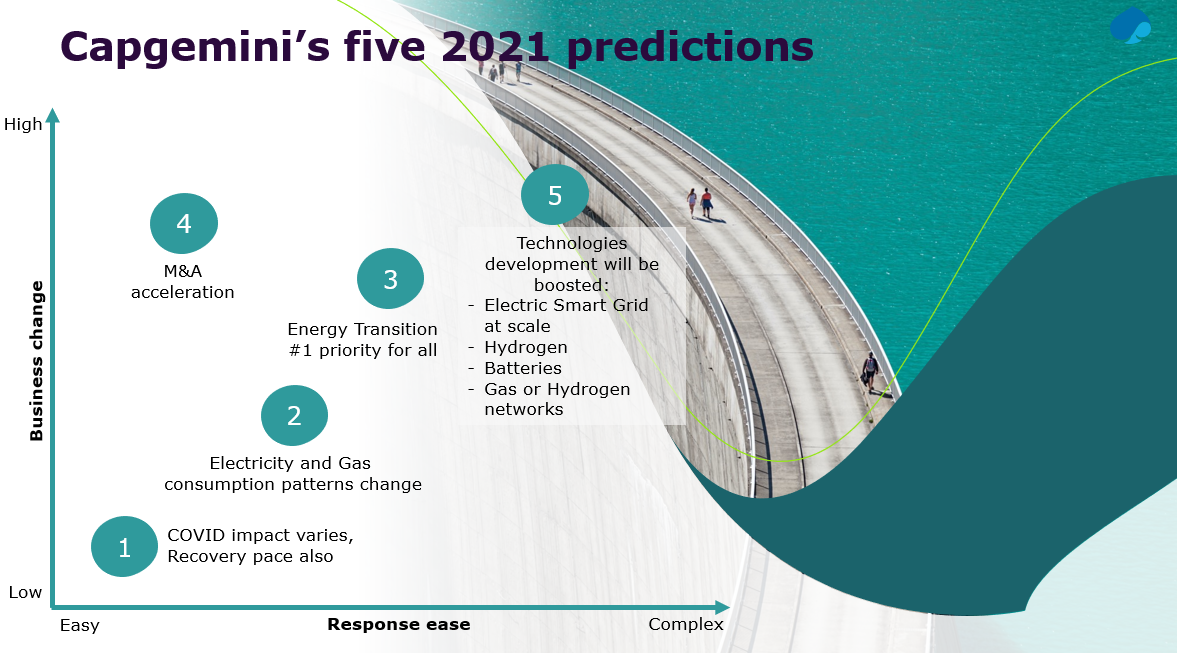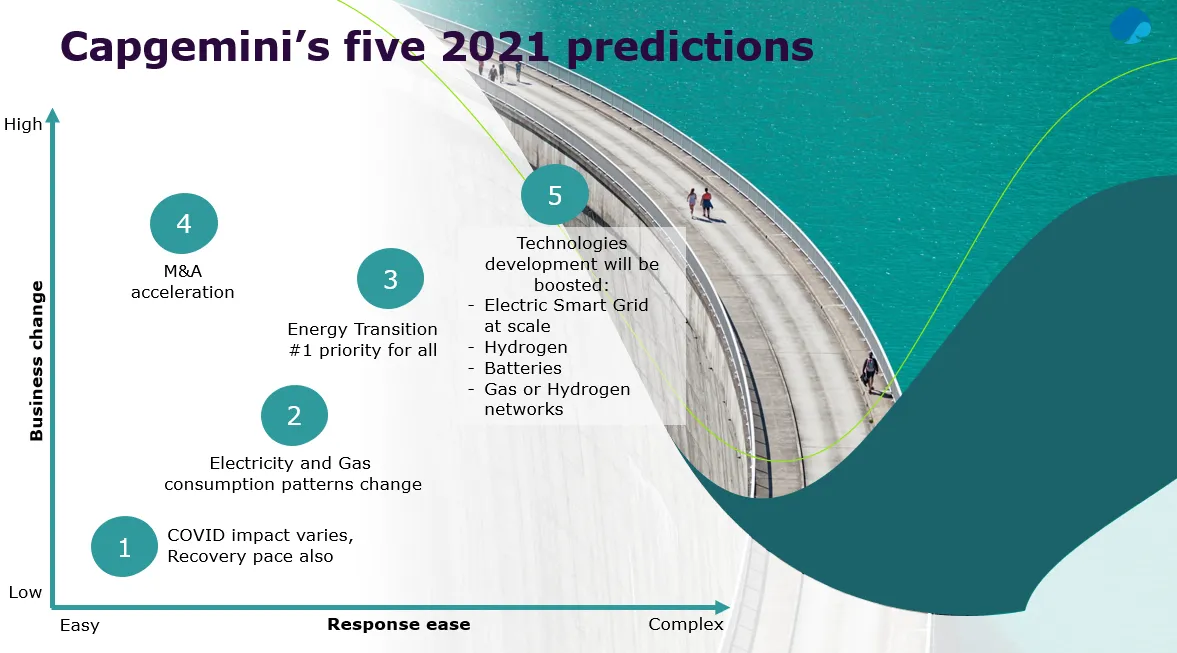Five predictions for the energy and utilities sector in 2021
Blog: Capgemini CTO Blog
Since 2020, the energy and utilities industry has been characterized by a balancing act between two opposing narratives:
The first holds that the trends related to energy transition, climate change, technological advancement, and the evolution of energy markets throughout 2019 have continued. The continuity of these trends consequently showed that the world is drifting far from the Paris Accord’s global warming increase target of 1.5–2 °C.
As a counterbalance, the second narrative holds that the profound industry-wide impact of COVID-19 in 2020 has, in many ways, reset the baseline and established a new normal.
Weighing these two narratives and their transformative effect on markets around the world, along with Capgemini’s own annual analysis from the World Energy Market Observatory, we’ve reached five key predictions for the energy and utilities sector in 2021.

- Global energy and utilities players have been significantly affected by the pandemic. The pace of recovery will vary across sectors, as regional players that demonstrate key attributes will be better positioned and have greater resilience in 2021.
The response to the pandemic in regions ranging from Asia, Europe, and North America, clearly shows that the impacts of the pandemic differ from one country to another. The speed of recovery will depend on several factors, including vaccine administration and availability, economic rebound, and the success of country recovery plans.
Some utilities are more affected than others; the impact on generation companies, suppliers, and services has been more significant than on grid operators. On the generation side, those that have fossil fuel generation are far more affected than those that have more renewables, because in a long market (with consumption decreasing), renewables with marginal variable costs are called first. Typically, electricity grid operators are in a better situation than gas networks.
The key attributes for fast recovery that the better-positioned players share include:
- A return to pre-pandemic market consumption levels
- Agility (incumbents can be less agile than new players)
- The ability to leverage new technologies, innovate and scale-up capability
- A clear energy transition mandate
- A solid balance sheet and low indebtedness.
We do not anticipate that operators will return to pre-pandemic volumes and market conditions before the end of 2022.
- Work, behaviors, and consumption patterns are evolving
Behavioral and workforce changes adopted by energy and utilities clients in 2020 helped define the new paradigm. Subsequently, energy and utilities firms will need to respond to changes in electricity and gas consumption – meaning that they will need to manage variable consumption patterns and meet new expectations and customer service demands. WFH will remain a reality for most of the year. The leap towards digitization that many organizations took during lockdown, such as implementing remote work arrangements, will become permanent. Those that embraced this trend will be in better shape than others.
Post-COVID crisis individual behaviors will also change. It will be a while, for example, before we see a return to previous travel patterns. Air transportation and fuel consumption will be impacted as well as tourism, leisure, housing, etc. This will change electricity and gas consumption patterns and oil volumes. Automated services will also grow, both for relationships with customers and energy services delivery. When consumption is back or close to pre-pandemic levels, consumption and emissions will rise again.
- Energy transition will define 2021, becoming the number-one priority for the whole energy and utilities sector.
Climate change mitigation will be played out in the next 10 to 15 years, and despite a significant carbon reduction triggered by the pandemic in 2020, we are not at all on the Paris Agreement trajectory.
Investments in renewable energy and carbon-free technologies will likely accelerate. With electricity markets’ overcapacity and carbon taxes increasing, even carbon tax economic measures aren’t strong enough – the impact on coal and gas players will be profound.
Demand for a cleaner planet continues and financial institutions are now investing mainly in clean generation sources and decarbonized energy uses. Energy transition, the new sector paradigm, became the raison d’etre of most European utilities and a core mission statement of energy companies all over the world. Oil majors could be permanently affected if oil prices fail to recover. Moreover, they are under challenging stakeholder pressure to achieve carbon neutrality. Diversification of international oil companies (IOCs) should accelerate and with new leadership in the United States, US IOCs will also move as European majors.
This need for transformation in the industry will shift the focus to energy transition (strategy, footprint, portfolio, communication, etc.). All energy and utilities sector stakeholders should keep in mind the case of Danish national oil company, ORSTED, which shifted to become an offshore wind operator in less than 10 years, multiplying it’s market value by 2.5x over the last three years and greater than that of BP.
- Multiple technology programs should accelerate, triggered by energy transition
Despite the financial impact of the COVID-19 crisis, energy and utilities players will prioritize the fulfillment of the energy transition project. Funding is set to increase in 2021 which will result in the accelerated development of multiple transition technologies, including smart grids, green hydrogen, and batteries.
Smart grids:
Smart grid deployment at scale has just started for major transmission and distribution (T&D) electric operators after years of experimentation. We are seeing programs with various components leveraging digital technology, which has finally matured. The key triggers and drivers comprise: renewable developments (intermittency and distribution) to manage bi-directional flows across the T&D grid as well as intermittency; the development of electric use cases (EV, electric transportation) that need network re-enforcement; the end of smart metering and installation of communication capabilities in the LV network; and greater technology maturity (e.g., new hard components, comms, IoT, and more). Further, decades and dozens of billions of euros will be invested in these technologies to drive progress. This includes investment in substation automation and virtualization, command control, SCADA software (e.g., ADMS, OMS, DERMS), GIS, asset management, and digital twins.
Batteries and hydrogen:
The battery market has evolved considerably over the past years and will continue to do so. This will especially be the case for electric vehicles and stationary batteries. Within this wider scenario, we will start to see an increasing need for recycling batteries and an increase in the second-life market. We are also starting to see more public funding for green hydrogen (inter-seasonal energy storage carrier) and this will have a positive impact on renewable gencos down the line. The use of hydrogen-based technology will require more green electricity generation; hydrogen will also have an impact on gas networks as it can be used for transmission and distribution (up to 5–10% hydrogen in the transported gas); but more to the point, firms will need to develop specific hydrogen networks and infrastructure to support this technology (some methane pipes could be converted as part of infrastructure development, dedicated new pipes will have to be developed).Energy transition around the globe requires the development of a number of the above technologies. The success of global energy transition programs will also require that various market conditions are met. This includes keeping technology costs acceptable, scaling up technology fast where it makes sense to create large markets. The transition also consists of evolving grid tariffs, skills development, political willingness and public support (subsidies). - Mergers and acquisitions in the energy and utilities landscape will grow in 2021.
Organizations will respond to market changes with caution as they prioritize recovery from the financial impact of the pandemic. Many European utilities and oil and gas players are also likely to struggle with debt. But, as all players are revisiting and shifting their strategies, most of them are looking forward to becoming a leader in energy transition.
Energy and utilities 2021 M&A landscape acceleration covers:
- 2020 and 2021 will prove to be difficult years, with revenue decreases of 5–10% for utilities and far more for IOCs. Slight margin decreases are also expected.
- OPEX, CAPEX review programs have been or will be launched across almost all operators
- Debt levels could become a concern, notably for European players (utilities) with actual leverage ratio, investment barriers, and for oil and gas majors looking for carbon neutrality, diversification, and renewal of reserves.
- Revisiting and shifting strategies has started as it relates to geographical presence, assets owned and operated/value chain arbitrage, as well as decisions leading to M&As (selling fast stranded assets, non-priority geographies or businesses, looking for acquisitions to accelerate business shifts).
- Energy services seem less attractive than in the past, because of low profitability, and social distancing obligations.
2021 will be a transformational year for Energy & Utilities. To keep up with news and insights from across these industries in 2021, be sure to follow Capgemini’s Energy & Utilities Industry LinkedIn page.
Author: Colette Lewiner and Philippe Vié
